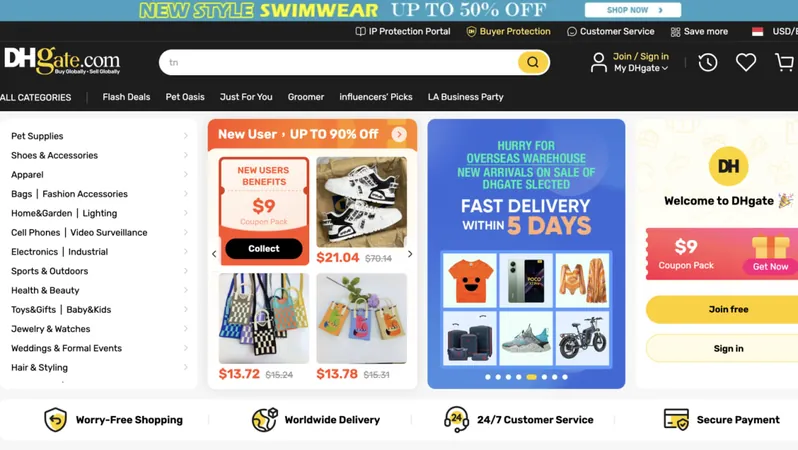
American Shoppers Flock to Chinese Apps to Beat Tariffs - Here’s How They’re Saving Big!
2025-04-17
Author: John Tan
As U.S. shoppers brace for impending tariff hikes on Chinese goods, a new trend is sweeping the nation. Consumers are rushing to popular Chinese e-commerce apps, hunting for the best deals on everything from sneakers to luxury bags before the deadline.
With the de minimis exemption set to expire on May 2—meaning anything valued at $800 or less could face new taxes—American buyers are piloting a digital gold rush to snag their purchases ahead of time. It’s a race against the clock, and shoppers are worried about what may come after the deadline.
A flurry of TikTok videos reveals this urgent shopping spree, where users are asking crucial questions: 'Will my order incur tariffs if it arrives after May 1?' This growing anxiety reflects a broader sentiment about rising prices as the U.S. and China continue their trade war.
According to Jason Yu from CTR Market Research in Beijing, consumers are proactively seeking alternatives to mitigate costs linked to tariffs. "They’re exploring different sources to find the products they want without breaking the bank," he said.
Surge in Popularity for Chinese Apps
Recent reports show that Chinese apps are dominating the U.S. App Store, with six out of the top eleven shopping apps coming from China. Among the leading platforms like Temu and Shein, the app DHgate—also known as the 'Little Yellow App'—has witnessed a staggering 940% increase in downloads, soaring to second place behind ChatGPT.
Founded in 2004, DHgate allows consumers to buy directly from manufacturers, adhering to the de minimis rule that makes it easier for shoppers to avoid costly tariffs.
The Social Media Influence on Luxury Purchases
This surge in Chinese apps isn’t just about saving money; it’s also fueled by a wave of TikTok content challenging traditional notions of luxury. Creators are highlighting how many expensive items may be produced in the same factories as their cheaper counterparts.
One TikTok video from creator Sen Bags showcased its production facility, asserting that they have supplied luxury brands for decades—raising the question: are consumers overpaying for just a logo?
The trend has struck a chord with price-sensitive buyers. As revealed in a viral TikTok rant, Swiss watches are reportedly made predominantly in China, despite their premium price tags. Creators are pulling back the curtain on high-end branding, urging viewers to reconsider the value of luxury goods.
Changing Perspectives on 'Made in China'
The perception of 'Made in China' has shifted dramatically. Once associated with low quality, products from China are now recognized for their role in global supply chains, often being the backbone of affordable production.
Experts emphasize that many popular consumer goods are sourced directly from Chinese manufacturers, making them significantly cheaper without the middleman markups.
As more Gen Z consumers embrace platforms like Taobao and Shein, they are increasingly savvy about their shopping choices, using social media to find the best bargains.
Navigating Potential Pitfalls
While this trend offers exciting possibilities for savings, experts warn that not everything is smooth sailing. Many Chinese platforms, including DHgate, are primarily designed for B2B transactions and are unprepared for individual consumer demands.
Challenges such as slow shipping, customer service, and handling returns may arise, especially as the scale of demand increases. Moreover, as shoppers delve into the world of Chinese-made products, concerns about quality and counterfeiting loom large.
With a surge in demand, Chinese platforms might face increasing scrutiny over compliance and intellectual property rights, leading to challenges down the road.
Despite these potential hurdles, it’s clear that savvy American consumers are finding ingenious ways to navigate the complexities of tariffs and global trade, potentially reshaping future shopping habits.

 Brasil (PT)
Brasil (PT)
 Canada (EN)
Canada (EN)
 Chile (ES)
Chile (ES)
 Česko (CS)
Česko (CS)
 대한민국 (KO)
대한민국 (KO)
 España (ES)
España (ES)
 France (FR)
France (FR)
 Hong Kong (EN)
Hong Kong (EN)
 Italia (IT)
Italia (IT)
 日本 (JA)
日本 (JA)
 Magyarország (HU)
Magyarország (HU)
 Norge (NO)
Norge (NO)
 Polska (PL)
Polska (PL)
 Schweiz (DE)
Schweiz (DE)
 Singapore (EN)
Singapore (EN)
 Sverige (SV)
Sverige (SV)
 Suomi (FI)
Suomi (FI)
 Türkiye (TR)
Türkiye (TR)
 الإمارات العربية المتحدة (AR)
الإمارات العربية المتحدة (AR)